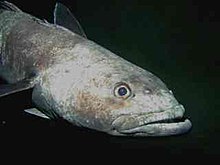Antarctic toothfish
| Antarctic toothfish | |
|---|---|
 |
|
| Dissostichus mawsoni in McMurdo Sound | |
|
Not evaluated (IUCN 3.1)
|
|
| Scientific classification | |
| Kingdom: | Animalia |
| Phylum: | Chordata |
| Class: | Actinopterygii |
| Order: | Perciformes |
| Family: | Nototheniidae |
| Genus: | Dissostichus |
| Species: | D. mawsoni |
| Binomial name | |
|
Dissostichus mawsoni Norman, 1937 |
|
Dissostichus mawsoni, the Antarctic toothfish, is a species of cod icefish native to the Southern Ocean. It is often mistakenly referred to as an Antarctic cod, consistent with the misnaming of other notothenioid Antarctic fish as rock cods. However, notothenioid fishes are unrelated to cods, which are in another taxonomic order, the Gadiformes. The generic name Dissostichus is from the Greek dissos (twofold) and stichus (line) and refers to the presence of two long lateral lines, which are very important to the species’ ecology. The common name "toothfish" refers to the presence of biserial dentition in the upper jaw, thought to give it a shark-like appearance. The habitat of the Antarctic toothfish is in subzero degree water below latitude 60°S.
Fully grown, these fish (and their warmer-water relative, the Patagonian toothfish, D. eleginoides) can grow to more than 1.7 metres (5 ft 7 in) in length and 135 kg in weight, twice as large as the next largest Antarctic fish. Being large, and consistent with the unstructured food webs of the ocean (i.e., big fish eat little fish regardless of identity, even eating their own offspring), the Antarctic toothfish has been characterized as a voracious predator. Furthermore, by being by far the largest midwater fish in the Southern Ocean, it is thought to fill the ecological role that sharks play in other oceans. Aiding in that role, the Antarctic toothfish is one of only five notothenioid species that, as adults, are neutrally buoyant. This buoyancy is attained at 100–120 cm in length and enables them to spend time above the bottom without expending extra energy. Both bottom-dwelling and mid-water prey are therefore available to them. Most other notothenioid fish and the majority of all Antarctic fish, including smaller toothfish, are confined to the bottom. Coloring is black to olive brown, sometimes lighter on the undersides, with a mottled pattern on body and fins. Small fish blend in very well among the benthic sponges and corals. They have a broad head, an elongated body, long dorsal and anal fins, large pectoral fins and a rudder-like caudal fin. They typically move slowly, but are capable of speed bursts that can elude predatory seals.
...
Wikipedia
